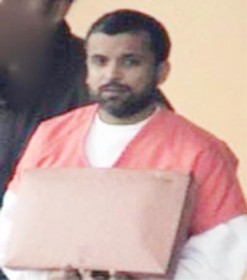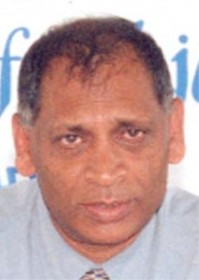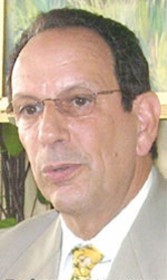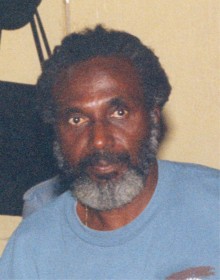Shaheed ‘Roger’ Khan was probably the most complete criminal in this country’s history. His guilty plea for trafficking in cocaine, witness tampering and gun running last March has robbed the nation of the detailed exposure of his criminal networks and relationships and leaves lots of questions unanswered.
Special Agent Cassandra Jackson of the United States Drug Enforcement Adminis-tration said it all. In her affidavit to support the charges against Shaheed ‘Roger’ Khan, she told a Federal court in Brooklyn that “Khan was ultimately able to control the cocaine industry in Guyana, in large part, because he was backed by a paramilitary squad that would murder, threaten, and intimidate others at Khan’s directive. Khan’s enforcers committed violent acts and murders on Khan’s orders that were directly in furtherance of Khan’s drug trafficking conspiracy.”
Drugs
According to Jackson, the US Government’s case was to establish that Khan was the leader of a “violent drug trafficking organisation” and that he and his co-conspirators obtained large quantities of cocaine and then imported the cocaine into the Eastern District of New York and other places for further distribution.
It was while he was managing his drug-smuggling business in neighbouring Suriname that the
law finally caught up with Khan. At home in Guyana, Khan seemed to enjoy a charmed existence of immunity from arrest and prosecution. His mistake, however, was to enter Suriname − a more law-abiding jurisdiction. There, his cocaine-constructed house of cards collapsed with his dramatic arrest in Paramaribo.
Suriname’s Minister of Justice Chandrikapersad Santokhi announced on 15th June 2006 that four Guyanese − Shaheed Khan, Sean Belfield, Lloyd Roberts and Paul Rodrigues − were among 12 persons arrested in a law-enforcement operation which netted 213 kg of cocaine. Two weeks later on 29th June, Khan was flown out of Johann Pengel International Airport, Paramaribo, on a Suriname Airways flight to Trinidad and Tobago. He was then handed over to immigration authorities upon arrival who then handed him over to US officials. Less than 24 hours after being expelled from Suriname, Khan was arraigned at the Brooklyn Federal Court in New York on 30th June on a charge of “conspiring to import cocaine” and was ordered to be detained at the Metropolitan Detention Centre in Brooklyn.
Khan’s arrest showed the stark contrast in the quality of governance between the two states. Suriname’s Chandrikapersad Santokhi deemed Shaheed Khan a threat to the national security of Guyana and Suriname and other countries and linked him to plots to assassinate government and judicial officials in that country. According to Santokhi, international agencies, including those in the USA, had been looking for him. On the other hand, Guyana’s Minister of Home Affairs at the time Gail Teixeira formally indicated to Suriname that the government had “no interest” in seeking Khan’s return at that time.
Chairman of the Central Intelligence Committee Dr Roger Luncheon added preposterously that
the Guyana Government could find “no compelling evidence” for Khan to be investigated. The administration, in fact, seemed more concerned about the modalities of Khan’s arrest than the atrocities of his crimes. Luncheon verbalized the administration’s concerns by iterating “its principled objection to the forceful and unlawful removal of its citizen across jurisdictions.”
The beginning of the end of Khan’s criminal career as Guyana’s most notorious drug-smuggler might have been the publication of the US Department of State’s Inter-national Narcotics Control Strategy Report for 2005 which was released in March 2006. The report for the first time named Khan and stated in part:
“Drug traffickers appear to be gaining a significant foothold in Guyana’s timber industry. In 2005, The Guyana Forestry Commission granted a State Forest Exploratory Permit for a large tract of land in Guyana’s interior to Aurelius Inc., a company controlled by known drug trafficker Shaheed ‘Roger’ Khan. Such concessions in the remote interior may allow drug traffickers to establish autonomous outposts beyond the reach of Guyanese law enforcement.”
The publication of the Report not only froze the forestry transaction but also sent a signal to the security forces to go after Khan while the President and the Head of the Presidential Secretariat were out of the country at the same time. Enforcement operations against Khan’s associates and properties were aided by the US Federal Bureau of Investigation.
Death squads
Khan was often accompanied by serving or former policemen, usually from the dreaded Target Special Squad. When he was arrested in Suriname, Paul Rodrigues, Lloyd Roberts and Sean Belfield were at his side. Indeed, Khan made no attempt to conceal his activities and his connections with the authorities. In a gratuitous display of hubris, he published a whole-page ‘Statement’ in the newspapers on 12th May 2006 boasting that “During the crime spree in 2002, I worked closely with the crime-fighting sections of the Guyana Police Force and provided them with assistance and information at my own expense. My participation was instrumental in curbing crime during this period.”
Indeed, he seemed deeply involved in some sort of savage, shadowy activity when, on Wednesday 4th December 2002, a Guyana Defence Force patrol in the area of Good Hope, East Coast Demerara, intercepted and searched a vehicle which contained an arsenal of weapons. The three-man hunting party discovered in the vicinity of the vehicle were Khan himself, Haroon Yahya and Sean Belfield, then a serving member of the Police Force. The cache included M-16 assault rifles with night vision devices; Uzi sub-machine gun with silencer; Glock 9mm pistols; 12-gauge shotgun; other small calibre weapons; bullet-proof vests; helmets; a computer and other electronic gadgetry with digitised electronic maps and plans of Georgetown and certain targetted East Coast villages.
As a vital part of the death squad’s operations, Khan was allowed to acquire intercept equipment which enabled him to listen to the conversations and determine the locations of his intended victims. Peter Myers, Co-director of the UK firm Smith Myers recently testified in court that the cellular intercept equipment used by Khan had been sold to the Guyana Government. Meyers identified the intercept equipment − including an intercept receiver and two laptops − and confirmed that it was sold by the company’s Florida sales office through the Fort Lauderdale-based Spy Shop to the Guyana Government. Testimony was led to the effect that Minister of Health Dr Leslie Ramsammy had purchased the equipment on behalf of the Guyana Government and that Carl Chapman, a representative of Smith Myers Communi-cations, had travelled to Guyana to train Khan in its use. Both the administration and Ramsammy strongly denied having any connection with the equipment.
Khan’s boast that he masterminded the suppression of the Troubles on the East Coast by using his own “resources” should not be regarded as an expression of altruism. What motive other than murder would one have with a wagonload of weapons in the dead of night? What drug-smuggler would not attempt to expand his market, extend his turf and eliminate his rivals? Khan might have posed as a self-proclaimed law enforcer but in fact waged his own drug-driven gang war. At this time, Ronald Gajraj was Minister of Home Affairs and Floyd McDonald was Commissioner of Police, both of whom had their USA visas suspended.
The period of ‘the Troubles’ on the East Coast is regarded as the most bloody phase in Guyana’s post-Independence history, during which dozens of men were shot to death or even disappeared. Of the numerous victims of violence, it became impossible to determine exactly who were the assailants and what were their motives. Who stood to gain from the execution of the deputy head of the Customs Anti-Narcotics Unit Vibert Inniss, the kidnapping of entrepreneur Brahmanand Nandalall, the murder of businessman Harry Rambarran, the attempted murder of the Director of Public Prosecution Denis Hanoman-Singh and the ‘Diwali massacre’ in Bourda? Could these crimes have been perpetrated by one or several competing cartels to expand their territory or to eliminate their enemies? There are more questions than answers!
George Bacchus, a self-confessed member of the death quad first made public evidence of the squad’s crimes and the possible involvement of high government officials. A Presidential Commission of Inquiry was established to investigate whether Minister of Home Affairs Ronald Gajraj was “involved in promoting, directing or otherwise engaged in activities which have involved the extra-judicial killing of persons.” The inquiry found, however, that there was no credible evidence against him. Owing to the limited nature of the inquiry, uncounted assassinations, executions, murders and extra-judicial killings remained unsolved and largely uninvestigated. In the final analysis, civil society, the public and aggrieved relatives boycotted the Inquiry after the star witness George Bacchus was shot dead in his bed at home. No evidence was led to incriminate the minister.
Both Gajraj and Mc Donald had left their key security posts by February 2004. Gail Teixeira was acting as Minister of Home Affairs and Winston Felix had been appointed Commissioner of Police. Under Felix, the special squad which had been accused of numerous extra-judicial killings and racketeering and was suspected of collaborating with Khan, was dismantled and many of its members dismissed. Khan, however, was rich enough to retain relations with most of the squad’s most notorious members who were taken into his employ as bodyguards, informants and more.
Selwyn Vaughn, another self-confessed former member of the death squad, recently provided fresh testimony of Khan’s involvement in murder. Vaughn testified that Khan ordered the execution of Ronald Waddell, an anti-Government talk-show host, at his home in Subryanville. Immediately after the murder, Khan is said to have reported the incident to Dr Leslie Ramsammy, Minister of Health. The US Government had also accused Khan of executing Donald Allison outside his home in Agricola and Dave Persaud outside the Palm Court Restaurant in Georgetown.
Khan felt threatened when the joint GDF-GPF operations targetted his businesses in 2006. He decided to strike back by releasing recordings to media houses of telephone conversations purportedly involving the Commissioner of Police Winston Felix. In a typical example of Guyana-style governance, the administration seized the opportunity not to prosecute Khan the felon who admitted distributing the recording, but to persecute Felix, its own commissioner. Khan was elated and claimed that, in releasing the recordings, he was acting to “expose, identify and curb corruption and incompetence” in the police force.
The confrontation continued with the Police Force publishing a ‘wanted bulletin’ for Khan. He disappeared from view but took to issuing statements through his lawyers and sponsoring advertisements in the press in which he contended ludicrously that he was perceived by persons in the USA, the Police Force, the Defence Force and the People’s National Congress party as someone who had the will and capacity to fight crime and to protect the people of Guyana against a coup d’État.
Dirty money
Khan’s criminal enterprise was financed with dirty money earned from drug-smuggling. The US government charged that a significant amount of the cocaine dispatched by Khan went to the Eastern District of New York for further distribution. As an example, it cited a Guyanese drug trafficking organisation − the Queens Cartel − based in Queens, New York, which it said was supplied by Khan and was said to have distributed hundreds of kilogrammes of cocaine. Khan is believed to have laundered his drug-smuggling profits through banks in New York through the “Queen’s Cartel” to which he supplied cocaine.
Arnold and Sabrina Budhram, accused of being Khan’s co-conspirators, were arrested and charged with money laundering in April 2004 and their home and offices were searched by investigators who gathered a large amount of evidential material. According to court documents, a handwritten “money and drug ledger” found their home and bank records indicated that in 2001, a company associated with the Budhrams transferred money to a bank account in the name of Khan’s wife and child.
At home in Guyana, the extent of Roger Khan’s interests and properties became evident only when the Defence Force and the Police Force launched their joint `Operation Centipede’ in March 2006. By that time, the security situation had taken a turn for the worst. Glenn Hanoman who is one of Khan’s lawyers, confirmed that his client entered the property business when he developed a housing scheme at Good Hope, East Coast Demerara, by building over 100 houses. Soon afterwards, Khan purchased a large expanse of land at Blankenburg, West Coast Demerara, where he built his second housing scheme, called the Hibiscus Scheme. Khan then embarked on the construction of a third scheme, at New Hope on the East Bank of Demerara. Khan then launched a fourth housing scheme at Farm, also on the East Bank. Khan is also proprietor of a timber company on Kaow Island and had interests in several night clubs and other enterprises.
Downfall
Khan was a crook. At all material times over the past 15 years, Khan’s criminal record was public knowledge. His criminal career began with a conviction in January 1992 in Montgomery County, USA, for breaking and entering and theft. While he was on probation for that offence, he was arrested in Burlington, Vermont, for receiving and possessing firearms while being a convicted felon. He was subsequently indicted and was released on bail in November 1993 but fled the jurisdiction to Guyana in 1994 in order to avoid prosecution. Despite being a felon and a fugitive from the law, he was able to move about Guyana with impunity and acquire property.
When asked to explain how such a crook was able to purchase public land that was put up for sale by the Guyana Sugar Corporation, President Jagdeo answered “Unless you have a conviction against a person, then you can’t say you can’t tender for public land.” The fact is that everyone knew that Khan was already a convict when he bought the properties!
Shaheed ‘Roger’ Khan was one of the most complete criminals in Guyana’s history. He acquired vast properties, recruited serving police officers, ordered executions, imported and exported cocaine, laundered millions of dollars, possessed specialised intercept equipment and armed himself with a wide assortment of handguns and ammunition. All of this was possible only because of his special relationship with the Guyana Government. He enjoyed immunity from an indulgent administration and compliant law enforcement agencies. Even now, the administration has made no attempt to conduct official inquiries nor has the police force attempted to bring Khan and his well-known accomplices to justice.
His successful application to United States District Court Judge Dora L Irizarry to plead guilty to trafficking in 150 kilogrammes of cocaine, witness tampering and gun-running, is an anti-climax to a callous criminal career. He will go to jail for a few years but will leave many questions unanswered.




